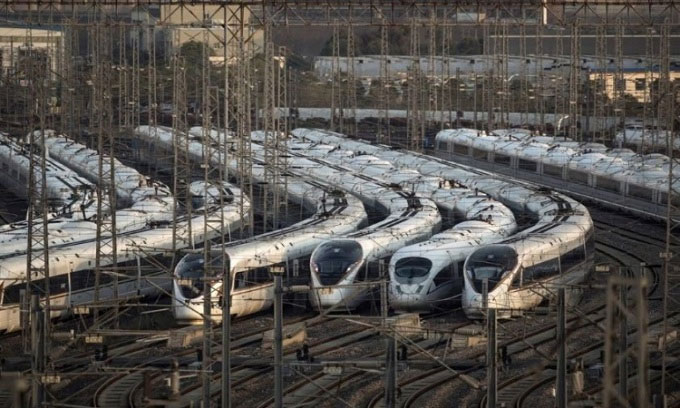The bullet train could reach speeds of 450 km/h by adding wings on top of the train, which helps increase lift and save costs.
A group of scientists in southwestern China proposed adding wings to bullet trains to increase speed. According to their research, installing five pairs of small wings on each train car would generate additional lift and reduce the train’s weight by one-third, raising the maximum speed to 450 km/h. This research is part of the CR450 project initiated by the government earlier this year to develop a new generation of high-speed trains capable of operating at that speed.

Current bullet trains in China have a speed of 350 km/h. (Photo: Bloomberg).
Currently, China’s high-speed rail network is among the fastest in the world, with bullet trains capable of traveling at 350 km/h. The CR450 project aims to develop trains that run nearly 30% faster, taking only 3 hours to travel from Beijing to Shanghai, or 5 hours from Beijing to Guangzhou. However, with the increased operating speed, the wear and tear on the wheels also increases, shortening the repair cycle and lifespan of the wheels, according to research by experts at the Chengdu Hydrodynamics Initiative Center, led by engineer Zhang Jun.
“The winged high-speed train is a breakthrough in aerodynamic design aimed at reducing energy consumption and operational costs,” the research team concluded in a paper published on November 18 in the Chinese journal Acta Aerodynamica Sinica.
The idea of adding wings to high-speed trains is not new. Japanese engineers proposed this concept in the 1980s with a train model featuring wings extending out like an airplane on both sides. They created a prototype two decades later. Although this initial effort demonstrated that the new design provided aerodynamic benefits, experts could not implement it in practice due to the wings being too large and wide for safe operation within the limited infrastructure of current railways, such as safety barriers and tunnels.
The proposal by Zhang and his colleagues is somewhat different. Instead of installing large wings on both sides, they suggest a series of small wings on top of the train that would generate sufficient lift without the risk of colliding with anything. However, the research team emphasized that the wings need to be designed and installed carefully. At a speed of 450 km/h, the train’s body would create a high-speed airflow near the surface of the roof, which could cause turbulence if the wings are placed too low. Conversely, if the wings are positioned too high above the train, the train could enter the airflow generated by the wings at the front, leading to greater drag than lift. The research team estimates the optimal height for the wings to be 1.5 – 2 meters above the train’s roof.
The most significant difference between the Chinese and Japanese proposals is that the Chinese design would operate more like a cruise missile than an airplane, according to Zhang and his colleagues. Chen Yu, an engineer at Tongji University in Shanghai, noted that there are still significant technical challenges to overcome when adding wings to trains. “For train designers, the smoother the surface, the better. Every additional component comes with its own issues,” Chen, an expert in studying the aerodynamic characteristics of high-speed trains in wind tunnels, shared.
For instance, the wings would increase noise in the cabin and reduce passenger comfort. Therefore, scientists and engineers will need to find ways to control the complex airflow over the train’s roof and absorb noise using soundproof materials or structures. This will contribute to an increase in the train’s overall weight.
High-speed trains draw power from overhead lines through a pantograph located at the front of the train. Experts will need to ensure that the pantograph maintains continuous contact with the overhead lines despite turbulence created by the wings. The first CR450 trains are likely to operate on a new 300 km railway between Chengdu and Chongqing, two major economic centers in the southwest region. Construction of the railway began in September 2021 and is expected to be completed within five years.
The CR450 program aims to address technical issues related to automation control, wheel design, steering systems, rail upgrades, and safety measures. The components of the wings will be cost-effective and feasible for large-scale application compared to maglev trains equipped with superconducting technology operating at speeds of 600 km/h.

















































